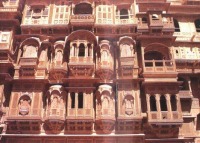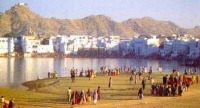Back in January 2004 Martin Wright, one the club’s most sociable regulars at the London Meetings, royally entertained a packed Crown Court with tales of his marathon cycle ride to Australia! Many in that audience will remember his great photos, distinctive narrative style and his thirst for adventure. Well Martin is at it again – this time he’s go back to the land down under to ‘pick up his bike and have a look round’. I think too many cold winter nights provided the motivation to get back on the road! This is the second in an occasional series, based on Martin’s emails, and charts his offbeat approach to the road ahead.
21st June: Arrived in DENMARK early this afternoon after a great few days of cycling to reach here. Even with the bloody wind in my face it was still enjoyable. Less traffic and big bloody road trains to deal with and of course less of the grey ghosts towing their bloody caravans! At any caravan park you are likely to see grey ghosts arriving during the course of the day and some of them are a real source of amusement. Most of them cannot reverse their caravan into a bay so drive around the park looking for a way to drive in – sometimes they have to get other people to move vehicles or get another driver to reverse the caravan for them! I think anybody towing a bloody caravan should take a driving test to prove they can reverse into a space. If they can't do it they should f*** off around Australia on a bus or better still stay at home… My bicycle is in good shape now I’ve had a few minor repairs completed. Should be in Perth in about in about one week and will write again from there…
20th July: Have finished with the south west corner and am now heading along the west coast. Am at present in Kalbarri, a small town about 500kms north of Perth but will have to get a move on now as I will need to be in Darwin by mid September as my visa will be at an end and I will need to fly up for a renewal. I spent far longer in the south west corner of the country than I intended – the weather was not at all good but the area is so beautiful I stayed an extra day almost everywhere I visited. The big tree country around Walpole is breathtaking – I visited the tree top walk which gives a real idea of just how big these bloody trees are. At Pemberton I climbed the Gloucester Tree, which is used as a lookout for bushfires and at 61 metres above ground you can see for miles! Don't climb it if you are afraid of heights as one or two people went about 10 metres up, became stuck and it took a while to bring them back down. Nannup was wonderful and I stayed at the 'black cockatoo' backpackers which was run by an interesting man whose fridge told his story… It was here I met the three young ladies who teased me somewhat and left me very frustrated. Visited Augusta for a spot of whale watching which was breathtaking and tried to hook a few but the line kept on snapping…
1st August: Reached sunny Exmouth on Friday. The journey up to Carnarvon and on to Exmouth was delayed by unseasonal heavy rainfall, which left me with a few short days of cycling. As a result I had to camp wild or stay at rest bays, which were usually full of caravaners but I did meet a few interesting and generous people along the way. On arriving at Nerren Nerren rest bay I was approached by an Aussie man, John, who presented me with a can of whisky and coke. After putting up my tent John called me over to sit under his caravan awning where I was given another drink as we chatted about Aussie rules football or aerial ping pong as I prefer to call it. The next course of cheese and biscuits along with nibbles and dips ensured we then got on to talking about cricket, whilst soon after John’s wife Heidi appeared and presented us both with steak, sausages, vegetables and mashed potatoes; totally delicious! Somewhat better than the two day old sausage sandwiches I was going to eat…
The following day I was held up by rain yet again and was plied with coffee from a 72 year old lady who has been travelling around Australia for the last five years with her pet shitzui. For the next couple of days this lady passed me on the road and at the next rest stop would pull up and have a cup of tea ready for when I arrived.
I finally arrived in Carnarvon last Sunday and found that the roads were flooded in places and I had to wade through 18 inches of water. At the caravan park I met a Dutch couple and together we visited the pub for a few beers – luckily they served Guinness, which was a welcome relief from the Aussie beer. The ride onwards from Carnarvon was again interesting! I’d camped in the bush one night and was woken first by a truck pulling up at around midnight. Soon after I was woken by voices and a torch shining on my tent – after this there were no more disturbances but I did not sleep at all well!
Visited Coral Bay, a beautiful beach resort but the caravan park was expensive and noisy.
The next day took me to the very flat and uninteresting countryside of Exmouth, which is thankfully surrounded on 2 sides by the Gulf of Exmouth and the Indian Ocean. On the ocean side is the CapeRangeNational Park and the Ningaloo Reef. Yesterday I took a bus to Turquoise bay and hired a snorkel, mask & flippers and visited the underwater wonderland. I saw a variety of colourful fish - some big, some small and some which frightened the living daylights out of me! I saw a turtle, a manta ray and a bloody great big leopard shark – indeed I spent far more time swimming than I realised and a great day was topped off by sunburn on my back.
Another rest day today and then tomorrow I am heading back to the highway and on to Karratha, which I hope to reach by next weekend. Should have more news by then…
Which countries are represented by these flags? For the answers, see at the end of the eNews.
|
|
|
|
|
|
| 1 | 2 | 3 | 4 | 5 |
Discuss this article and give feedback in our online forum

 Jaipur, popularly known as the Pink City, was
founded in 1727 AD by the Maharaja of Amber Sawai Jai Singh.
This remarkable city is considered a marvel of town planning.
Designed in accordance with ancient Hindu treaties on
architecture, the Silpa Shastra, Jaipur follows a grid system
and is encircled by a fortified wall. The palace lies
in the heart of the city and occupies the space of the
central grid. The rest of the grids were cut across neatly by
wide lanes, which divided the area into tidy, well laid-out
rectangles of commercial and residential use. The fortified
wall has eight gates (originally had seven) and was built for
protection against invading armies and wild animals. Today
the city has spread beyond these walls and reached
neighbouring towns and continues to grow.
Jaipur, popularly known as the Pink City, was
founded in 1727 AD by the Maharaja of Amber Sawai Jai Singh.
This remarkable city is considered a marvel of town planning.
Designed in accordance with ancient Hindu treaties on
architecture, the Silpa Shastra, Jaipur follows a grid system
and is encircled by a fortified wall. The palace lies
in the heart of the city and occupies the space of the
central grid. The rest of the grids were cut across neatly by
wide lanes, which divided the area into tidy, well laid-out
rectangles of commercial and residential use. The fortified
wall has eight gates (originally had seven) and was built for
protection against invading armies and wild animals. Today
the city has spread beyond these walls and reached
neighbouring towns and continues to grow.
 Held at Pushkar near Ajmer once in a year,
better known by the name of Pushkar Cattle Fair, is one of
the most colourful festivals of India. Thousands of pilgrims
come to bathe in the holy water of the Pushkar Lake. Legend
has it that the lake appeared miraculously on the spot, where
the petals of the lotus fell from the hands of lord Brahma.
Pushkar has an atmosphere of an ancient town, peaceful and
secluded but for twelve days of the month of KARTIK (Hindu
calendar), it transformed into a spectacular fair ground.
The fair is an amazing sight to behold including street
sellers showing off their dazzling range of wares in hundreds
of roadside stalls.
Held at Pushkar near Ajmer once in a year,
better known by the name of Pushkar Cattle Fair, is one of
the most colourful festivals of India. Thousands of pilgrims
come to bathe in the holy water of the Pushkar Lake. Legend
has it that the lake appeared miraculously on the spot, where
the petals of the lotus fell from the hands of lord Brahma.
Pushkar has an atmosphere of an ancient town, peaceful and
secluded but for twelve days of the month of KARTIK (Hindu
calendar), it transformed into a spectacular fair ground.
The fair is an amazing sight to behold including street
sellers showing off their dazzling range of wares in hundreds
of roadside stalls.
 People come from different parts of
Rajasthan to worship lord Brahma and take bath in the holy
lake. Pilgrims start coming in the early morning in
groups singing the religious songs dedicated to Hindu gods to
bathe in the Pushkar lake. The process continues throughout
the day to turn into DEEPDAN ceremony. The entire
atmosphere reverberates with the ringing of bells. At
night, hundreds of small oil lamps placed on green leaves set
the lake alight. Shopkeepers keeps their shops open day
and night for the last three or four days to keep the city
alive.
People come from different parts of
Rajasthan to worship lord Brahma and take bath in the holy
lake. Pilgrims start coming in the early morning in
groups singing the religious songs dedicated to Hindu gods to
bathe in the Pushkar lake. The process continues throughout
the day to turn into DEEPDAN ceremony. The entire
atmosphere reverberates with the ringing of bells. At
night, hundreds of small oil lamps placed on green leaves set
the lake alight. Shopkeepers keeps their shops open day
and night for the last three or four days to keep the city
alive.
 The ceremony over, it opened to the public and
suddenly it became what it was meant to be. The sun
shone, the temperature soared, the people filled the
memorial, people from all walks of life and different parts
of the world; dipping their feet and walking in the cool
water.
The ceremony over, it opened to the public and
suddenly it became what it was meant to be. The sun
shone, the temperature soared, the people filled the
memorial, people from all walks of life and different parts
of the world; dipping their feet and walking in the cool
water.
